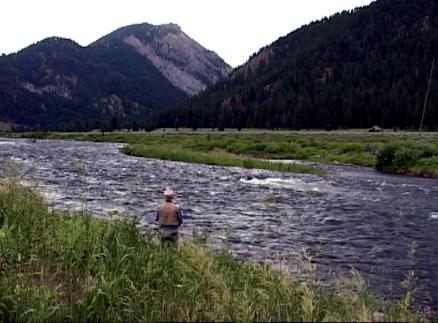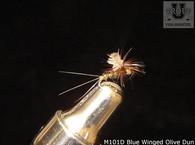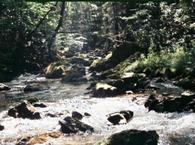
The Madison River is certainly a magnificent river and probably the most famous river and arguably the best trout river in the world. It is often described as the "Fifty Mile Riffle" which covers that section from Hebgen Lake near the Yellowstone National Park to just below the Bear Trap Canyon near Ennis Montana. Incidentally, Hebgen Lake is also a very productive trout fishery consisting of large rainbows and browns.
However, the Madison originates at the confluence of the Firehole River and the Gibbon River within the Yellowstone National Park. The park portion of the Madison River has been previously detailed in Troutu Streams Report “Yellowstone National Park”. In general the Madison River is a tailwater fishery but it resembles a classical freestone stream which flows at a rate of approximately 5 miles per hour over a cobble bottom without plunges, rapids, or fast runs. It does however, have some big boulders that form some pocket water.
After leaving Hebgen Lake, the Madison flows through Quake Lake (caused by the 1959 earthquake) and Ennis Lake and then continues on its 130 mile journey to Three Forks, Montana, where the Madison River, the Jefferson River and the Gallatin Rivers are combined to form the Missouri River.
The one and one half mile stretch from Hebgen Lake to the Quake Lake contains deep pools, deep runs, and riffles and the water temperature remains in the 40 to 50 degree range. From February to early June, this section is full of spawning rainbows, some of which have come up from Quake Lake. Likewise, October and November brings the large browns upstream from Quake Lake to spawn. As you might suspect this section is open to fish year around.
The water pours over the slide dam of Quake Lake, and down a long, narrow chute into the Slide Inn Run providing a great stretch to fish for large trout. Below Quake Lake is a section of aggressive water that falls under the general Montana fishing Regulations with the season starting on the 3rd Saturday of May and runs through February. So, starting in late May gives little time to fish before the June runoff occurs. After the runoff starts this section is impossible to fish, however by the first part of July the runoff has been completed and the fishing will become excellent.
Only wade fishing is permitted from Slide Inn to Lyon Bridge and this nine mile section has many access points. This section is full of full of large rainbows and brown trout making it the most popular section of the Madison River. This water can be best described as sections of long riffles with some pocket water created by a few large boulders.
About a mile above the Lyon Bridge, the water is joined by the waters of the West Fork that can be extremely muddy during the annual runoff. This 30 mile section of the Madison from Lyon Bridge all the way to Ennis can be defined by the abundant aquatic insect hatches, starting with the famous Salmonfly hatch in early July. Also during July you will see the Golden Stoneflies, Green Drakes and Pale Morning hatching along with the Blue Winged Olives and the Yellow Quills. Starting in late July and August the great caddisfly hatches take place causing a frenzy with the trout feeding vigorously on them until it is completely dark or around 10:00 P. M.
The first portion of this section, from Lyon Bridge down to McAtee Bridge consists of pocket water, created by large boulders, mixed with the long riffles, while the next section from McAtee Bridge downstream to Varney Bridge, consist mostly of riffles. From Varney Bridge downstream to Ennis Lake, however, there are fewer access points. The browns that are found in this section are usually somewhat larger and they enjoy the additional cover provided by the small islands.
Fishing the Madison River:
Much of the Madison can be waded and much of it can be both waded and fished from a drift boat, accessibility is easy and it is gentle with fly fishing beginners, but t the same time it is not a “push over” either. Wherever you select to fish this majestic river, there are plenty of big wild rainbow and brown trout. It is well known for its abundant aquatic insect hatches. Since the Madison is so large and has so many different sections, it is well to check with the State of Montana for the fishing regulations as several different regulations apply.
Spring:
Spring will see the excellent mayfly and caddisfly hatches and of course midges will be productive. The runoff usually is complete by the end of June depending on the weather.
Summer:
Starting in July after the runoff is completed, the Salmon fly and the Yellow Stonefly hatches will receive most of the attention, also in August are the Tricos and the Callibaetis Mayfly hatches. But do not forget the terrestrials. Both dry flies and nymphs should work well. Fishing the Madison is a great joy in the summer.
Fall and Winter:
The, brown trout are spawning and the late season blue-winged Olives hatch is underway and there's much less fishing pressure so it is an ideal time to visit the Madison. Remember that streamers will remain good through the fall season and into the winter season as well. Midges will continue to be available for the trout all winter long so be sure to include some midge nymphs in your fly box.
See our Madison River Hatch Chart before your day on the river!
Access to the Madison River is very good along Route 287 and some other secondary roads; and there are campgrounds at Palisades and Ruby Creek as well. The nine mile section from Slide Inn to Lyon Bridge has many access points including the famous $3.00 bridge. The section of the river from Lyon Bridge downstream to Ennis Lake can be fished by drift boats and a boat launching area is available at McAtee Bridge.
To fish the Varney to Ennis portion of the Madison, I suggest that you make the town of Ennis your starting point. However, if you plan to fish the portion from the Hebgen Dam to Varney, I suggest that you make West Yellowstone your home base.
A map of the specific access points is available here.
Stream Flows:
Real Time USGS Data Hebgen Dam
Real Time USGS Data Kirby Ranch
Real Time USGS Data Downstream from Ennis Lake
View Western USA in a larger map





